Land EKG
Land EKG
 Land EKG is a tested range monitoring system developed in the USA by 4th generation rancher Charlie Orchard, now implemented in Canada as well. Although originally designed to measure and monitor the function and productivity of rangeland, the established monitoring protocol has been expanded to include measurements for wildlife habitat suitability (i.e., for Sprague’s Pipit, a species-at-risk in Alberta). In addition to measuring habitat suitability, participants have also tracked wildlife occurrence through a complementary sound- and camera-monitoring Acoustic Recording Unit (ARU). To date, 12 OGC members have over 20 Land EKG transects in Alberta’s grassland region, which influences roughly 15,000 acres.
Land EKG is a tested range monitoring system developed in the USA by 4th generation rancher Charlie Orchard, now implemented in Canada as well. Although originally designed to measure and monitor the function and productivity of rangeland, the established monitoring protocol has been expanded to include measurements for wildlife habitat suitability (i.e., for Sprague’s Pipit, a species-at-risk in Alberta). In addition to measuring habitat suitability, participants have also tracked wildlife occurrence through a complementary sound- and camera-monitoring Acoustic Recording Unit (ARU). To date, 12 OGC members have over 20 Land EKG transects in Alberta’s grassland region, which influences roughly 15,000 acres.
Why is Land EKG an important tool?
Incorporating habitat suitability measurements into existing Land EKG protocol will not only provide a real-time assessment for Sprague’s Pipit (or other SAR) occurrence, but—continued on a regular basis—also can serve as a record of maintenance, improvement and/or potential enhancement of grassland habitat. As the concept of Ecological Goods and Services (and payment for) becomes increasingly known to the general public, programs like Land EKG and the use of wildlife monitoring techniques ensure that landowners are already in position to demonstrate existing stewardship successes. Therefore, Land EKG is a good vehicle for a combination productivity-habitat monitoring approach, as it incorporates measures for both economic and ecological gains.


